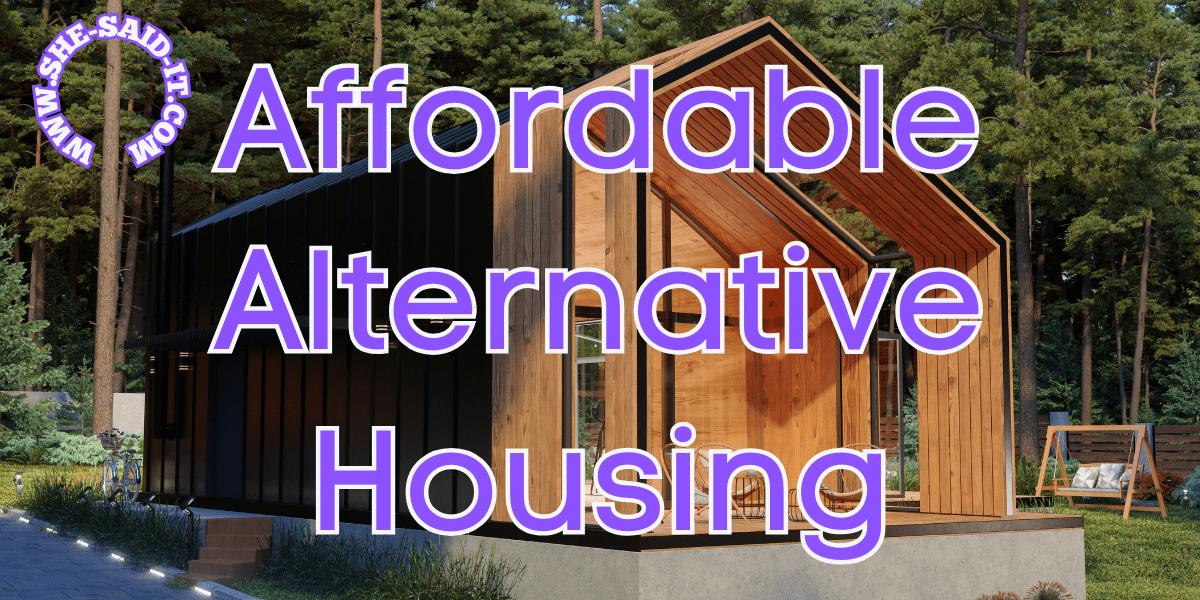Budget-Friendly Housing Options: Exploring Affordable Alternative Housing
The Journey into Affordable and Unique Dwellings
In today’s rapidly escalating economic landscape, the dream of homeownership is becoming increasingly elusive for many Canadians. The persistent rise in the cost of living, coupled with skyrocketing real estate prices, has led to a growing phenomenon of individuals and families becoming ‘house poor’ – a term that resonates with those spending a disproportionate amount of their income on housing. This financial strain is prompting a reevaluation of traditional living arrangements and sparking interest in more affordable, sustainable housing solutions.
As we navigate through these challenging times, the allure of off-grid living and the simplicity it offers is becoming more appealing. This guide delves into a diverse array of budget-friendly housing alternatives that not only alleviate the financial burdens of conventional homeownership but also resonate with a desire for a lifestyle closer to nature. From the compact charm of tiny houses and the rustic appeal of Bunkies, to the modern innovation of shipping container homes and the mobility of Park Model RVs, each option presents a unique pathway to a more affordable and fulfilling living experience. We will also explore the practicality of modular and prefab homes, and the adventurous lifestyle afforded by full-time RV living, especially in models equipped for all seasons.
This exploration is more than just a survey of housing types; it’s a journey into a new paradigm of living, where financial freedom, environmental consciousness, and personal fulfillment converge. As we journey through these alternatives, we uncover not just a means to escape the financial hardships of traditional housing, but also a way to redefine what it means to call a place ‘home.’
On the Road to Home: Charting My Affordable Housing Adventure
My adventure into affordable alternative housing started when I decided to live in a 5th wheel RV. This wasn’t just about moving into a smaller space; it was a whole new way of looking at what ‘home’ means. Living in an RV has shown me how great it is to have a home that’s flexible, close to nature, and simple.
Moving into the RV was a big step. It’s been full of learning curves, like getting the hang of RV upkeep and loving the view that changes whenever I want it to. This way of living has taught me a lot about keeping things simple and being kind to the environment.
Now, I’ve got this piece of unrestricted land, and it’s like a blank slate waiting for me to do something with it. I’m thinking about all kinds of options, from environmentally friendly Earthships to quaint cob houses. As I figure out what to do with the land, I’m bringing all the lessons I learned from RV life. And I want to take you all along for the ride as I explore these options. Let’s see where this journey takes us!
Overview of Affordable Alternative Housing Options:
- Tiny Houses in Canada: Tiny houses symbolize a shift towards minimalism and sustainability. These compact dwellings, typically less than 400 square feet, are a beacon of efficiency and creativity. In Canada, they have emerged as a popular choice due to their lower costs and reduced environmental impact. A 2019 study showed that tiny house owners in Canada saved an average of 55% on housing costs compared to traditional homes. Personal stories, like that of a Vancouver couple who built their tiny dream home for under $100,000, underscore the practicality and charm of these miniature abodes.
- Shipping Container Homes: Shipping container homes are a creative and eco-friendly addition to the landscape of affordable alternative housing in Canada. These homes, constructed from repurposed shipping containers, offer a unique blend of durability, affordability, and modern design. Known for their robustness and ability to withstand harsh conditions, shipping containers are an ideal building material for those looking to create a sustainable and cost-effective living space. The adaptability of these containers allows for a wide range of architectural designs, from simple, single-container studios to elaborate multi-level homes. While they present certain challenges, such as insulation for colder climates and navigating zoning regulations, shipping container homes continue to grow in popularity among Canadians seeking an innovative and budget-friendly housing solution.
- Bunkies: Bunkies are a charming staple in Canada’s affordable alternative housing scene, offering a compact and versatile solution for those seeking extra space without the hassle of extensive construction. Typically under 107 square feet, these cozy cabins often bypass the need for a building permit in many municipalities, simplifying the setup process. Their appeal lies in their simplicity and cost-effectiveness, making them ideal for use as guest quarters, personal retreats, or creative studios. Embraced in areas like Ontario’s cottage country, Bunkies provide a quaint escape into nature, blending rustic charm with practicality. Their small footprint also presents opportunities for eco-friendly enhancements, aligning with a sustainable lifestyle.
- Park Model RVs: Park Model RVs present a unique blend of mobility and comfort in the realm of affordable alternative homes in Canada. Designed to provide more space and amenities than traditional RVs, yet smaller and more affordable than typical homes, these models offer a practical solution for those seeking a semi-permanent living space. Generally sized at around 400 square feet, Park Model RVs are ideal for individuals and families looking to downsize or embrace a more nomadic lifestyle without sacrificing home comforts. Their design often includes features like full kitchens, bathrooms, and sleeping areas, making them a popular choice in Canadian RV parks and resorts. Although they require a location that permits RV living, Park Model RVs offer a flexible and cost-effective option for those exploring alternative housing solutions.
- Modular Homes: Modular homes represent a modern approach to home building in Canada, combining efficiency with customizability. Constructed in factory settings as separate modules and then assembled on-site, these homes streamline the building process, significantly reducing construction time and material waste. This method offers homeowners the flexibility to design their homes according to their specific needs and preferences, ranging from layout configurations to aesthetic choices. The controlled environment of factory construction ensures consistent quality and can lead to cost savings compared to traditional building methods. Modular homes are increasingly popular among Canadians looking for a quick, cost-effective, yet personalized housing solution.
- Prefab Homes: Prefab (prefabricated) homes encompass a range of building styles, including modular, panelized, and pre-cut homes, each offering a unique approach to construction. What unifies them is the process of manufacturing sections or panels of the home in a factory before transporting them to the building site for assembly. This method allows for greater precision and quality control, often resulting in more energy-efficient and sustainable homes. Prefab homes in Canada offer a versatile solution for homebuyers, catering to a variety of designs, from ultra-modern to traditional, and can be tailored to fit different budgets and preferences. Their growing popularity reflects a shift towards more environmentally conscious and efficient building practices in the housing market.
- Yurts: Yurts, with their origins in Central Asia, have found a new home in Canada. These circular tents offer a unique combination of simplicity and functionality. Modern yurts come equipped with insulation, windows, and even plumbing, making them a viable option for year-round living. A family in Ontario, for example, chose a yurt for its affordability and quick setup, allowing them to live debt-free while building their permanent home.
- Earthships: Earthships are the pinnacle of sustainable living. Built from natural and recycled materials, they are designed to generate their own power, harvest water, and maintain a comfortable climate. In Canada, these eco-homes have been embraced in provinces like Manitoba, where the climate challenges have been met with innovative design adaptations. The Earthship community near Winnipeg, for example, showcases how these homes can thrive in Canada’s varied climate.
- A-Frame Houses: A-Frame houses are more than just charming; they are a testament to practical and aesthetically pleasing design. Known for their steep roofs and cozy interiors, A-Frames are particularly suited to snowy regions, as their design naturally prevents snow accumulation. In British Columbia, a resurgence in A-Frame construction reflects a blend of nostalgia and modern energy efficiency.
- RV Living: Living in an RV has become an increasingly popular option for those seeking affordable and flexible housing in Canada. For full-time living, choosing the right RV is crucial, with many models specifically designed to accommodate long-term occupancy. These RVs often feature enhanced amenities like increased storage, more comfortable living spaces, and efficient heating and cooling systems. A key consideration for Canadian climates is selecting an RV with a winter package or being four-season capable, ensuring it is well-insulated and equipped to handle various weather conditions, from freezing winters to hot summers. This adaptability makes such RVs ideal for exploring the vast and diverse landscapes of Canada year-round, providing a unique blend of home comfort and the freedom of the open road.
- School Bus Conversions (Skoolies): The Skoolie movement turns retired school buses into fully functioning homes on wheels. This trend has gained momentum among Canadians who cherish flexibility and adventure. The process involves gutting the bus and customizing the interior with living essentials. In Alberta, a young couple transformed a bus into a stylish, mobile home for under $30,000, exemplifying the potential of Skoolies as an affordable housing option.
- Cob Houses: Cob houses, made from a mixture of clay, sand, straw, and water, are an ancient building technique re-emerging as a sustainable housing solution. These homes are labor-intensive but incredibly cost-effective, often built with materials sourced directly from the land. In British Columbia, a community project demonstrated how a small cob house could be constructed for as little as $5,000, offering a viable, eco-friendly alternative for those willing to invest their time and energy.
Navigating Municipal Bylaws and Regulations:
Embarking on the journey of alternative housing requires a thorough understanding and navigation of the intricate maze of municipal bylaws and regulations. Each municipality in Canada possesses its own unique set of rules that govern aspects such as construction, zoning, and land use. This diverse regulatory environment can significantly impact the feasibility and legality of various housing options. For example, the regulations around tiny houses, a popular form of alternative housing, can vary widely. In some areas, tiny houses on wheels are classified under RV regulations, while in others, they are considered akin to permanent structures, each with its own set of compliance requirements.
Navigating these regulations can sometimes be daunting, especially for those new to the world of alternative housing. Zoning laws are particularly critical, as they determine the permissible use of land in different areas. These laws can influence several aspects of your housing project, such as the allowable size of the structure, the distance it must be set back from property lines, and even the types of materials you can use. Furthermore, in some cases, the intended use of the structure – whether as a primary residence, a secondary suite, or a temporary accommodation – can also impact the applicable regulations. For instance, the rules for a park model RV used as a seasonal dwelling might differ from those for a similar structure used year-round.
Given these complexities, engaging with local planning departments early in your project is essential. These departments can provide up-to-date, detailed information about the specific bylaws in your area and help guide you through the approval process. Additionally, seeking advice from experts in the field, such as architects, builders, and legal professionals who specialize in alternative housing, can be incredibly beneficial. They can offer insights into how to design and build your home to ensure it meets all legal and safety requirements. This expert guidance can prove invaluable in navigating the often complex and varied landscape of municipal regulations, helping you to avoid potential legal pitfalls and ensure that your alternative housing project is both compliant and successful.
Spotlight on British Columbia:
British Columbia is at the forefront of supporting affordable alternative housing. The province’s new laws regarding Accessory Dwelling Units (ADUs) provide more options for homeowners to add secondary units on their property. The incentive program is particularly appealing, offering a forgivable loan that covers up to 50% of construction costs, up to $40,000. This initiative not only helps homeowners offset the costs but also encourages the development of a diverse range of housing solutions within the community.
The Importance of Community and Location:
The success of an alternative housing project often hinges on the surrounding community and the specific location. Factors like climate, access to resources, and community support play a significant role. For example, a tiny house might be more suitable in a region with milder weather, while an Earthship could thrive in a more remote, sun-rich environment. Researching and connecting with local communities that are receptive to alternative housing is vital for a successful transition.
Turning Dreams into Reality: The Affordable Housing Revolution
This exploration of affordable alternative housing options in Canada showcases a revolution in the way we think about homes. Each option, from tiny houses to cob houses, offers a unique pathway to homeownership, free from the burdens of conventional mortgages and high living costs. As more Canadians embrace these alternatives, we witness a shift towards a more sustainable, community-oriented way of life.
Join the Conversation: Your Path to Affordable Living
Are you considering stepping into the world of affordable alternative homes in Canada? We’d love to hear your thoughts, experiences, or plans for embracing this lifestyle. Share your journey in the comments below, or ask questions about making the transition to a more cost-effective, off-grid lifestyle. Let’s build a community of knowledge and support for all those embarking on this exciting path!








Appreciating the time and energy you put into your blog and in depth information you present.
It’s good to come across a blog every once in a while that isn’t
the same out of date rehashed information. Wonderful read!
I’ve saved your site and I’m adding your RSS feeds to my Google account.